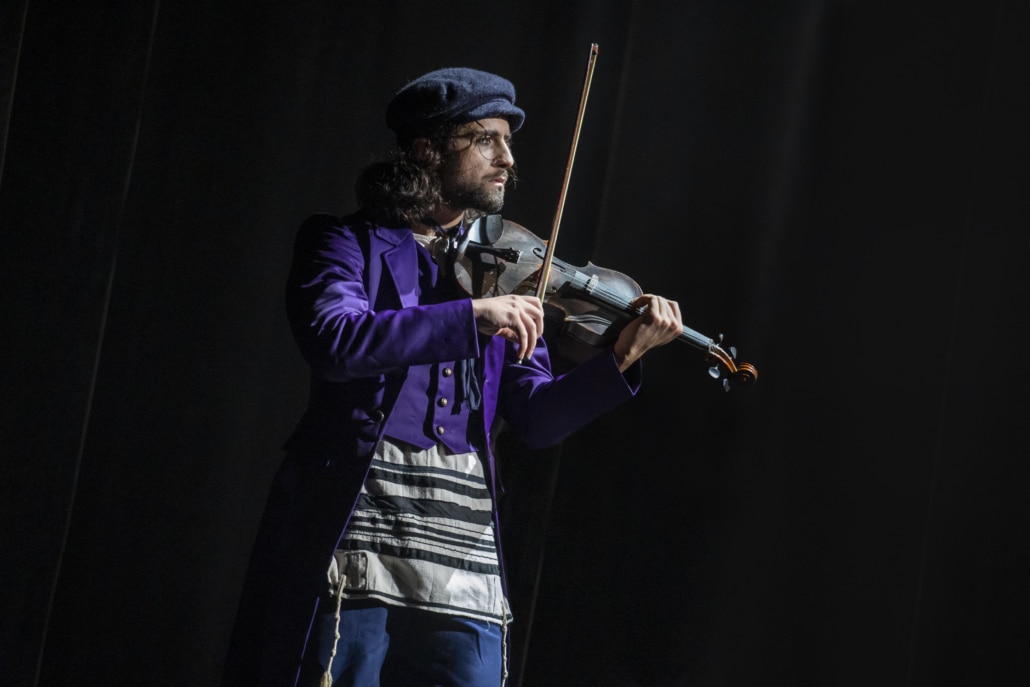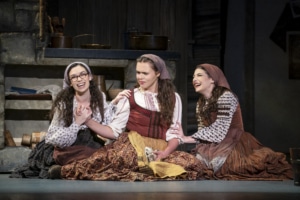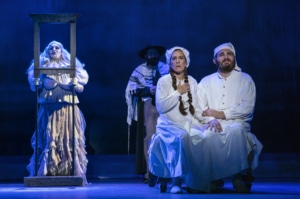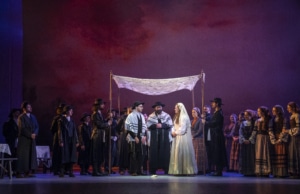DCPA NEWS CENTER
Enjoy the best stories and perspectives from the theatre world today.
Enjoy the best stories and perspectives from the theatre world today.
From the archives: originally published in June 2019

Ali Arian Molaei (The Fiddler) and the Company of the North American Tour of FIDDLER ON THE ROOF. Photo by Joan Marcus
Fiddler On the Roof. You’ve heard of it, yes? Unless you’re Rip Van Winkle and a long time asleep, how could you not? Based on some of Sholem Aleichem’s short stories, Fiddler is among the most beloved and widely disseminated of American musicals. True, we’ve had Hamilton, The Book of Mormon and Spamalot since.

Yardén Barr (Chava) and Randa Meierhenry (Tzeitel) and GraceAnn Kontak (Hodel) in the North American Tour of FIDDLER ON THE ROOF. Photo by Joan Marcus
One is a take on American history, the second a spoof of missionary misadventures, the third about a kibitzing bunch of galloping knights. But Fiddler…? About impoverished Jews in Russia at the start of the 20th century? Why?
You might well ask. Its own creators had doubts. They wanted to make a musical about Anatevka, a dirt-poor Russian shtetl (village) home to mostly destitute Jews, by focusing on the hardscrabble life of its milkman, Tevye, his wife Golde, their five daughters, his lame horse, chickens, cows and geese. These people were viewed with scorn by the host country, Russia, that eventually offered them a Sophie’s choice: pogrom (massacre) or exile. Guess what they chose?
It took three American descendants of these exiled Jews — composer Jerry Bock, lyricist Sheldon Harnick and bookwriter Joseph Stein — to consider enshrining all that misery in a show.
Bock and Harnick had collaborated on the 1959 Tony Award-winning musical Fiorello! about New York City’s popular Mayor Fiorello H. LaGuardia, and were looking for another project. They knew the Aleichem stories were a tough subject, but the stories were close to their hearts. Their parents came from Russia and from just such circumstances. Since they had worked with Joseph Stein on the musical Tenderloin and knew his own background matched theirs, they decided to ask him to join them.
He did.
Even knowing the odds of finding success in this venture were low, they persisted. But translating tales of poverty, separation and exile into song and dance took effort and, well, patience, more of it than they’d anticipated. Trial and error made them realize they needed help — more players in the game, preferably some with skin in this history.
Read more: Emily Lozow on how Fiddler on the Roof changed my life
They decided to approach the eminent producer/director Harold Prince, but Prince, who was German-Jewish (as opposed to Russian) did not wholly embrace the project. He urged the creators to go after director/choreographer Jerome Robbins.
Robbins, born Rabinowitz (a derivation of Aleichem’s own birth surname), was very busy, but also interested. After months of delays — as outlined in Barbara Isenberg’s meticulous book Tradition! on the making of this musical — Robbins came on board in 1963. Taking a deep dive, he turned into an indispensable ringmaster and was just the man to try to whip this project into shape.

The Company of the North American Tour of FIDDLER ON THE ROOF. Photo by Joan Marcus
“Whip” is the word. Robbins was a known martinet. He had a rigorous, often tyrannical work ethic that was admired, but also dreaded as much as it was revered. He did not suffer fools, and he also did not always know what he was looking for, but he could always spot it when he found it.
This made for plenty more trial and error. A contentious issue arose with the casting of Zero Mostel as Tevye. Robbins had named names during the House Un-American Activities Committee hearings, something Mostel could not forgive. But the two men respected one another as artists and learned to tolerate each other for the sake of the work. The wayward Mostel, however, was not above taunting Robbins by throwing a lot of improvisational clowning into the gears. If Robbins was the ringmaster, Prince, who by now had joined the company as producer, became the referee — a buffer during a long and trying rehearsal period.
He started by asking the three originators of the idea what they thought this musical should be and then turned the question on its head. He badgered them into finding the right flavor, hitting the right notes, engaging in the contradictions of pride, forbearance, anger, optimism, regret and hope. Those characteristics are baked into the Jewish DNA, along with the determination to overcome and survive. Ritual is the Jewish anchor. Also tradition; now there’s a title for a song …

The Company of the North American Tour of FIDDLER ON THE ROOF. Photo by Joan Marcus
The longer Stein, Bock and Harnick worked with Robbins, the clearer it became that what they had thought of as a small parochial tale was much more universal. Placing Tevye’s story in that broader frame answered the deeper questions: What makes us strong? What is courage? What are morality and love?
Invigorated, they kept writing and composing, also injecting a good deal of found humor, while Robbins kept rejecting and refining. This went on until they nailed what they were all looking for in a process that, in the end, honored and rewarded everyone. The modest idea born in the late 1950s became a powerful reality on September 22, 1964, when Fiddler on the Roof opened on Broadway. You know the rest. The statistics are overwhelming, with a huge international success, a movie, five Broadway revivals, productions in almost any country or language you can mention, including a stirring new one in Yiddish (amazingly, a first) making fresh waves in New York.
This 55-year survival is no accident, with a score derivative of its ancient musical roots, inspired lyrics and a book that respects and elevates its origins. Bock is quoted in Isenberg’s book saying that, while they wrote Fiddler as they would any other show, “those embers … kept burning underneath.”
As for the title and that melancholy figure on the roof, an image taken from Marc Chagall’s painting, it was, Chagall said, that of a drunken uncle and mediocre fiddle player who clambered on the roof when he was in his cups to play his violin. Chagall allowed its use on one condition: The music had to reflect his uncle’s off-key playing.
Da-da-da-da-de-de-de-de-de-de-dum …
DETAILS
Fiddler on the Roof
March 14 – 19 • Buell Theatre
Tickets
